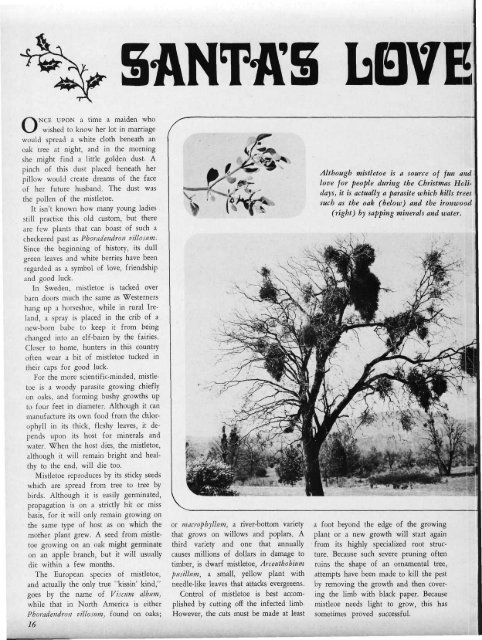DECEMBER, 1971 50c - Desert Magazine of the Southwest
DECEMBER, 1971 50c - Desert Magazine of the Southwest
DECEMBER, 1971 50c - Desert Magazine of the Southwest
Create successful ePaper yourself
Turn your PDF publications into a flip-book with our unique Google optimized e-Paper software.
ONCE UPON a time a maiden who<br />
wished to know her lot in marriage<br />
would spread a white cloth beneath an<br />
oak tree at night, and in <strong>the</strong> morning<br />
she might find a little golden dust. A<br />
pinch <strong>of</strong> this dust placed beneath her<br />
pillow would create dreams <strong>of</strong> <strong>the</strong> face<br />
<strong>of</strong> her future husband. The dust was<br />
<strong>the</strong> pollen <strong>of</strong> <strong>the</strong> mistletoe.<br />
It isn't known how many young ladies<br />
still practice this old custom, but <strong>the</strong>re<br />
are few plants that can boast <strong>of</strong> such a<br />
checkered past as Phoradendron villosum.<br />
Since <strong>the</strong> beginning <strong>of</strong> history, its dull<br />
green leaves and white berries have been<br />
regarded as a symbol <strong>of</strong> love, friendship<br />
and good luck.<br />
In Sweden, mistletoe is tacked over<br />
barn doors much <strong>the</strong> same as Westerners<br />
hang up a horseshoe, while in rural Ireland,<br />
a spray is placed in <strong>the</strong> crib <strong>of</strong> a<br />
new-born babe to keep it from being<br />
changed into an elf-bairn by <strong>the</strong> fairies.<br />
Closer to home, hunters in this country<br />
<strong>of</strong>ten wear a bit <strong>of</strong> mistletoe tucked in<br />
<strong>the</strong>ir caps for good luck.<br />
For <strong>the</strong> more scientific-minded, mistletoe<br />
is a woody parasite growing chiefly<br />
on oaks, and forming bushy growths up<br />
to four feet in diameter. Although it can<br />
manufacture its own food from <strong>the</strong> chlorophyll<br />
in its thick, fleshy leaves, it depends<br />
upon its host for minerals and<br />
water. When <strong>the</strong> host dies, <strong>the</strong> mistletoe,<br />
although it will remain bright and healthy<br />
to <strong>the</strong> end, will die too.<br />
Mistletoe reproduces by its sticky seeds<br />
which are spread from tree to tree by<br />
birds. Although it is easily germinated,<br />
propagation is on a strictly hit or miss<br />
basis, for it will only remain growing on<br />
<strong>the</strong> same type <strong>of</strong> host as on which <strong>the</strong><br />
mo<strong>the</strong>r plant grew. A seed from mistletoe<br />
growing on an oak might germinate<br />
on an apple branch, but it will usually<br />
die within a few months.<br />
The European species <strong>of</strong> mistletoe,<br />
and actually <strong>the</strong> only true "kissin' kind,"<br />
goes by <strong>the</strong> name <strong>of</strong> Visctim album,<br />
while that in North America is ei<strong>the</strong>r<br />
Phoradendron villosum, found on oaks;<br />
16<br />
SftNTft'i L0YE<br />
or macrophylliim, a river-bottom variety<br />
that grows on willows and poplars. A<br />
third variety and one that annually<br />
causes millions <strong>of</strong> dollars in damage to<br />
timber, is dwarf mistletoe, Arcenthobium<br />
pusillum, a small, yellow plant with<br />
needle-like leaves that attacks evergreens.<br />
Control <strong>of</strong> mistletoe is best accomplished<br />
by cutting <strong>of</strong>f <strong>the</strong> infected limb.<br />
However, <strong>the</strong> cuts must be made at least<br />
Although mistletoe is a source <strong>of</strong> fun and<br />
love for people during <strong>the</strong> Christmas Holidays,<br />
it is actually a parasite which kills trees<br />
such as <strong>the</strong> oak (below) and <strong>the</strong> ironwood<br />
(right) by sapping minerals and water.<br />
a foot beyond <strong>the</strong> edge <strong>of</strong> <strong>the</strong> growing<br />
plant or a new growth will start again<br />
from its highly specialized root structure.<br />
Because such severe pruning <strong>of</strong>ten<br />
ruins <strong>the</strong> shape <strong>of</strong> an ornamental tree,<br />
attempts have been made to kill <strong>the</strong> pest<br />
by removing <strong>the</strong> growth and <strong>the</strong>n covering<br />
<strong>the</strong> limb with black paper. Because<br />
mistleoe needs light to grow, this has<br />
sometimes proved successful.

















